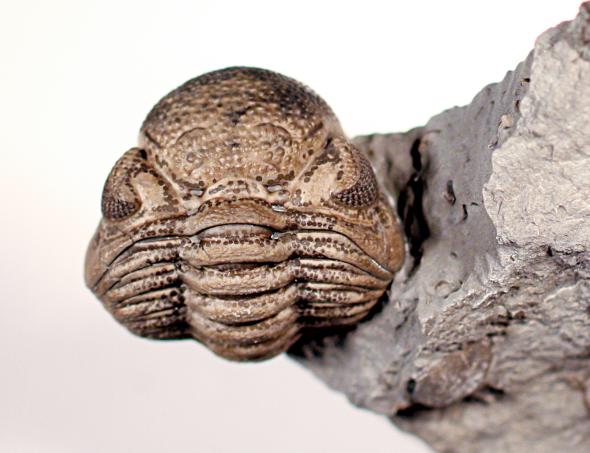Jane J. Lee | National Geographic News | Published March 27, 2013
Spots running down the length of the animals could have been used to confuse predators.

Perhaps the best-known group of ancient animals after dinosaurs, trilobites spent hundreds of millions of years coming up with crazy body plans and cruising the ocean before dying out some 250 million years ago. Now, a new study says that at least one species of these marine arthropods, Eldredgeops rana, found in what is today central and western New York, rocked spots.
“These would be the first [known] trilobites to have pristine markings unaltered by the fossilization process,” said SUNY Cortland paleontologist Christopher McRoberts, lead author of the new paper published March 18 in Geology.
People have noticed markings on the exoskeleton, or shell, of trilobites for almost a century, McRoberts and his co-authors wrote.
But papers published in the 1960s and 1980s found that the spots were either minerals incorporated into the shells during fossilization, or external markings of internal structures such as muscle attachments, said McRoberts.
The 1980s study, he added, found that the markings were actually deposits of pyrite, or fool’s gold, that had been preserved in the shell.
When a SUNY maintenance worker collected some trilobites from Devonian Age deposits (about 380 million years old) in an area of the state stretching from Syracuse to Buffalo and brought them to McRoberts, the paleontologist thought the spots on the back of the specimens would also turn out to be pyrite.
Original Spots
But when McRoberts and his colleagues ran chemical analyses on sections of the exoskeleton, they found no secondary minerals—including pyrite—within the spots.
The markings, which look like freckles running down most of the length of the animal and beneath its eyes, also weren’t associated with internal muscle attachments.
The researchers could see small tubes or pores at the bottom of each spot, which aren’t normally preserved. McRoberts said that those pores led his team to believe that these specimens were exceptionally well preserved, and that the spots were original markings.
Based on these lines of evidence, the scientists concluded that the markings were actual spots these animals would have had in life.
“There is no obvious indication of changes [in the spots], so an assumption that they are original seems reasonable,” George Clark, a paleontologist at Kansas State University in Manhattan who was not involved in the work, said in an email.
Questionable Appearance
Further analysis by McRoberts and his co-authors found that the spots were actually spheres filled with tiny crystals of calcite. The spheres weren’t colored, but the team believes the shells were.
This opens up several possibilities for what the trilobites might have looked like, McRoberts said—including that they may have had white spots against a colored exoskeleton, or clear spots that exposed a colored epidermis underneath the shell.
Clark added that these spots probably would have had multiple reflective surfaces and were perhaps brighter than expected.
McRoberts noted that modern-day crustaceans have white spots, as well as bright or iridescent markings—although they create them by different means than the Devonian trilobites. (Pictures: “Masters of Undersea Camouflage.”)
Form and Function
How these ancient animals used their markings is also open to debate. McRoberts said it’s likely they were a kind of camouflage.
“These trilobites were scavengers on the seafloor, and they would have been preyed upon by fish or cephalopods from above,” he said. The spotted patterning would have broken up the animal’s outline, perhaps preventing a predator from recognizing the trilobite.
But Clark cautioned against ascribing a function for the spots on an extinct organism, noting that it’s very difficult to know for sure how the animal used them.
Next, McRoberts plans to explore other trilobite species for similar markings—and to dive deeper into the structure of the calcite spheres.
He’d also like to figure out whether these spots are a regional difference or not. Specimens of E. rana found in other places don’t show the markings present on the ones from central and western New York.
“Maybe the spots are in the others,” said McRoberts, “but we just haven’t seen them because they’re not so well preserved.”









